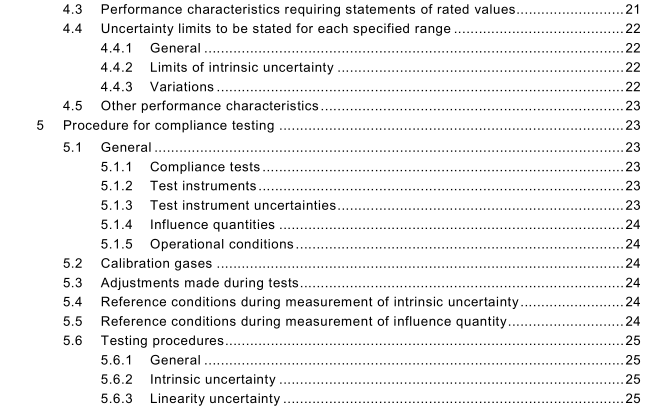IEC 61207-1:2010 pdf download – Expression of performance of gas analyzers – Part 1: General
3.2 Basic terms and definitions
3.2.1 measurand quantity subjected to measurement, evaluated in the state assumed by the measured system during the measurement itself NOTE 1 The value assumed by a quantity subjected to measurement when it is not interacting with the measuring instrument may be called unperturbed value of the quantity. NOTE 2 The unperturbed value and its associated uncertainty can only be computed through a model of the measured system and of the measurement interaction with the knowledge of the appropriate metrological characteristics of the instrument that may be called instrumental load.
3.2.2 (result of a) measurement set of values attributed to a measurand, including a value, the corresponding uncertainty and the unit of measurement [IEC 60050-311, 311-01-01, modified]
NOTE 1 The mid-value of the interval is called the value (see 3.2.3) of the measurand and its half-width the uncertainty (see 3.2.4).
NOTE 2 The measurement is related to the indication (see 3.2.5) given by the instrument and to the values of correction obtained by calibration. NOTE 3 The interval can be considered as representing the measurand provided that it is compatible with all other measurements of the same measurand. NOTE 4 The width of the interval, and hence the uncertainty, can only be given with a stated level of confidence (see 3.2.4, NOTE 1).
3.2.3 (measure-) value mid element of the set assigned to represent the measurand NOTE The measure-value is no more representative of the measurand than any other element of the set. It is singled out merely for the convenience of expressing the set in the format V ± U, where V is the mid element and U the half-width of the set, rather than by its extremes. The qualifier “measure-” is used when deemed necessary to avoid confusion with the reading-value or the indicated value.
3.2.4 uncertainty (of measurement) parameter, associated with the result of a measurement, that characterizes the dispersion of the values that could reasonably be attributed to the measurand
NOTE 1 The parameter can be, for example, a standard deviation (or a given multiple of it), or a half-width of an interval having a stated level of confidence.
NOTE 2 Uncertainty of measurement comprises, in general, many components. Some of these components can be evaluated from the statistical distribution of the results of a series of measurements and can be characterized by experimental standard deviations. The other components, which can also be characterized by standard deviations, are evaluated from the assumed probability distributions based on experience or other information. [IEC 60050-311, 311-01-02, ISO/IEC Guide 99, 2.26 modified]
NOTE 3 It is understood that the result of the measurement is the best estimate of the value of the measurand, and that all components of uncertainty, including those arising from systematic effects, such as components associated with corrections and reference standards, contribute to the dispersion.
NOTE 4 The definition and notes 1 and 2 are from GUM, Clause B.2.18. The option used in this standard is to express the uncertainty as the half-width of an interval with the GUM procedures with a coverage factor of 2. This choice corresponds to the practice now adopted by many national standards laboratories. With the normal distribution a coverage factor of 2 corresponds to a level of confidence of 95 %. Otherwise statistical elaborations are necessary to establish the correspondence between the coverage factor and the level of confidence. As the data for such elaborations are not always available, it is deemed preferable to state the coverage factor. This interval can be “reasonably” assigned to describe the measurand, in the sense of the GUM definition, as in most usual cases it ensures compatibility with all other results of measurements of the same measurand assigned in the same way at a sufficiently high confidence level.
